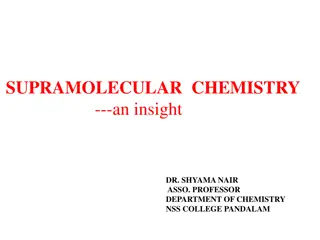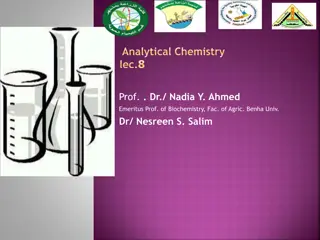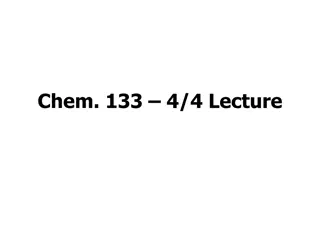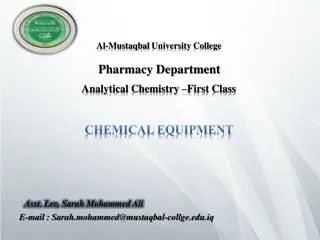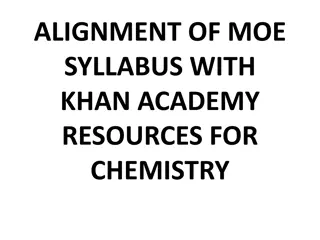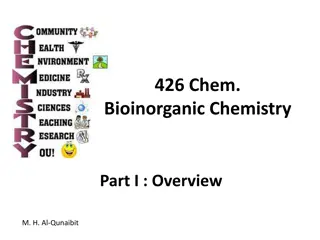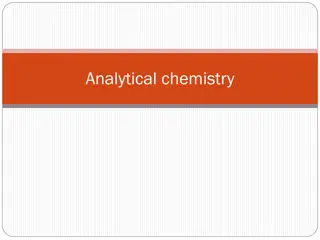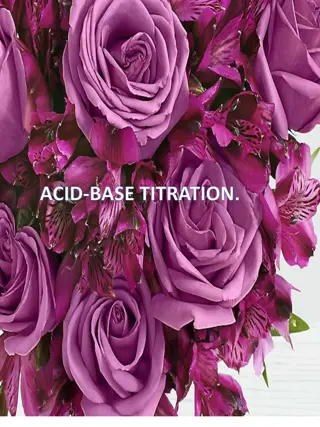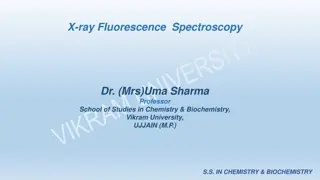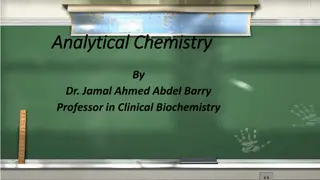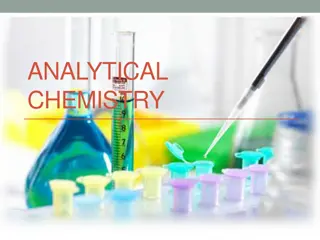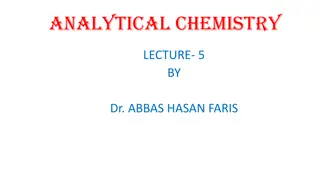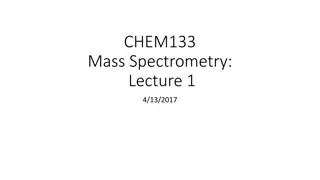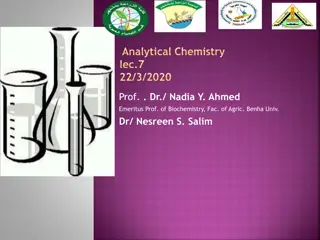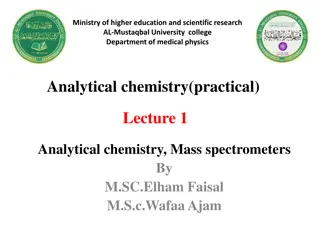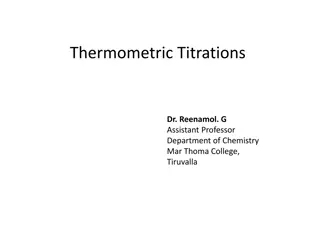Analytical Chemistry Basics
Analytical chemistry involves separating, identifying, and determining components in a sample. Qualitative analysis focuses on identifying compounds in a sample, while quantitative analysis determines the amounts present. Analytical chemistry is based on principles of qualitative and quantitative analysis and involves determining analytes expressed as percentages, parts per million, parts per billion, molarity, normality, and mole fraction. The chemical composition of aqueous solutions is discussed, highlighting the roles of solvents and solutes. Water is a common solvent, and two types of solvents are described – aqueous and organic.
Download Presentation

Please find below an Image/Link to download the presentation.
The content on the website is provided AS IS for your information and personal use only. It may not be sold, licensed, or shared on other websites without obtaining consent from the author.If you encounter any issues during the download, it is possible that the publisher has removed the file from their server.
You are allowed to download the files provided on this website for personal or commercial use, subject to the condition that they are used lawfully. All files are the property of their respective owners.
The content on the website is provided AS IS for your information and personal use only. It may not be sold, licensed, or shared on other websites without obtaining consent from the author.
E N D
Presentation Transcript
References :- 1-Fundamental of analytical chemistry by Douglas A. Skoog and Donald M. West 2-Quantitative_Chemical_Analysis by Vogel,_Arthur 5th edition 3-Quantitative Chemical Analysis by Daniel C. Harris
Analytical chemistry: The branch of chemistry that deals with the separation, identification and determination of components in a sample. Analytical chemistry deals with methods for the identification of one or more of the compounds in the sample of matter and the determination of the relative amounts of each.
Analytical chemistry is based on two principles: Identification of the compounds which means qualitative analysis (what is in the sample). Determination of the compounds which means quantitative analysis (you have to know exactly the amount of the compound in the sample). So we can say that qualitative analysis is a preliminary step of quantitative analysis. Qualitative analysis: Attempting to identify what materials are present in sample. Quantitative analysis: Determining how much of material is present in a sample. Always qualitative analysis must be done before quantitative analysis
Analytes: Are the components of a sample that are to be determined. The results are always expressed as: 1-Percentage (%) a)Weight percent (W/W) % Define as the number of grams of solute in 100g of solution. b)Volume-volume percent (V/V) % . Define as the number of milliliters 0f solute in 100 milliliters of solution. c)Weight-Volume percent (W/V) % Define as the number of grams of solution in 100 milliliters of solution. 2-Parts per million (ppm) When we have trace amount of solute in the sample (1mg/1L) 3-Parts per billion (ppb)
4-Molarity (M) Define as the number of moles of solute in one liter of solution. 5-Normality (N) Define as the number of equivalence of solute in one liter of solution. 6-Mole fraction Xa = na/na+nb Xb = nb/na+nb n = number of moles
The Chemical Composition of Aqueous Solutions Solutions are homogeneous mixture. The major component is called solvent, and the minor components are called solute. When gas or solid material dissolve in a liquid, the gas or solid material is called the solute. When two liquids dissolve in each other, the major component is called the solvent and the minor component is called the solute. Water is the most available solvent on earth, is purified, and it is not toxic. There are two types of solvent: 1-Aqueous solvents 2-Organic solvents Solution = Solvent + Solute
1-Electrolytes Are solutes which ionize in a solvent to produce an electrically conducting medium. There are two types of electrolyte solutes: a) Strong electrolytes Solute is completely ionized in the solvent (100%). e.g. Strong inorganic acids HCl H+ + Cl- HI H+ + I - HNO3 H+ + NO3 H2SO4 H+ + HSO4 - -
b)Weak electrolytes Solute is partially ionized in the solvent. e.g. Weak inorganic acids H2PO4- + H+ HPO4-2 + H+ PO4-3 + H+ H3PO4 H2PO4- HPO4-2 H2CO3 H+ + HCO3- HCO3- H+ + CO3-2 Weak organic acids CH3COO- C2H5O- H+ CH3COOH C2H5OH + H+ +
Classification of electrolytes Strong electrolyte 1-The inorganic acids: HCl, HBr, HI, HNO3, H2SO4, HClO4 Weak electrolyte 1- Some inorganic acids: HSO4-, H2S, H2CO3, H3PO4, H3BO3 Most organic acids HCOOH, CH3COOH 2-Alkali and alkaline earth hydroxides NaOH, KOH, Ca(OH)2 3-Most salts KCl, NaCl, Na2SO4, CH3COONa 2- Ammonia and most organic bases 3- Halides, cyanides and thiocyanides of Hg, Zn and Cd.
2. Acids and Bases Arrhenius definition: Acid: A substance that produced hydrogen ion (H+) in water solution. Base: A substance that produced hydroxide ion (OH-) in water solution. Bronsted definition: Acid: Proton (H3O+) donor Base: Proton (H3O+) acceptor Lewis Definition: Acid: Electron pair acceptor Base: Electron pair donor
Conjugate Acids and Bases: The product formed when an acid donate a proton is a potential proton acceptor and is called the conjugate base of the parent acid. Example: acid1 base1 + proton conjugate base Similarly, every base produces a conjugate acid as a result of accepting a proton. That is, base2 + proton acid2 conjugate acid When these two processes are combined, the result is an acid-base or neutralization reaction. acid1 + base2 base1 + acid2
Examples of conjugate acid-base relationship are shown in the following equations: 1- HNO2 + H2O NO2- + H3O+ acid1 base2 conjugate base1 conjugate acid2 nitrous acid water nitrite ion hydronium ion Water acts as a proton accepter (base) in an aqueous solution of nitrous acid. The conjugate base of the acid HNO2 is nitrite ion (NO2-). The conjugate acid of water is hydrated proton (H3O+) which is called the hydronium ion, and consists of a proton covalently bonded to one water molecule.
2- NH3 + H2O NH4+ + OH - base1 acid2 conjugate acid1 conjugate base2 ammonia water ammonium ion hydroxide ion In this reaction, ammonia (base1) reacts with water (acid2) to give the conjugate acid ammonium ion (acid1) and hydroxide ion which is the conjugated base (base2) of the acid water.
3-Amphiprotic Species: Species possess both acidic and basic properties. An example is dihydrogen phosphate ion (H2PO4-) which behaves as a base in the presence of a proton donor such as H3O+ H2PO4 base1 acid2 acid1 base2 - + H3O+ H3PO4 + H2O While in the presence of proton acceptor such as hydroxide ion (OH-), H2PO4- behaves as an acid and donates a proton to form a conjugate base HPO4-2 H2PO4- + OH - HPO4-2 + H2O acid1 base2 base1 acid2
Amphiprotic solvents behave as acids in the presence of basic solutes and bases in the presence of acidic solutes. Water is a classic example of an amphiprotic solvent; because it exhibit both acidic and basic properties depending on the solute. Other example for amphiprotic solvents is methanol. NH3 + CH3OH CH3O- + NH4+ base2 acid1 conjugate base1 conjugate acid2 CH3OH + HNO2 NO2- + CH3OH2+ base1 acid2 conjugate base2 conjugate acid1
4-Autoprotolysis (autoionization) Autoprotolysis involves the spontaneous reaction of molecules of substance to give a pair of ions. base1 + acid2 acid1 + base2 H2O + H2O H3O+ + OH - CH3OH + CH3OH CH3OH2 HCOOH + HCOOH HCOOH2 NH3 + NH3 NH4 + + CH3O- + + HCOO- + + NH2 -


